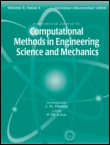
International Journal for Computational Methods in Engineering Science & Mechanics
Scope & Guideline
Exploring Cutting-Edge Computational Techniques for Engineering Excellence
Introduction
Aims and Scopes
- Computational Modeling and Simulation:
The journal emphasizes the development and application of computational models and simulations across various engineering disciplines, including structural, thermal, and fluid dynamics. - Finite Element Analysis (FEA):
A core area of focus includes finite element methods for analyzing complex materials and structures, addressing issues such as dynamic response, stability, and optimization. - Multiscale and Multifidelity Approaches:
The journal explores multiscale modeling techniques and multifidelity approaches that integrate various levels of detail in simulations to improve computational efficiency and accuracy. - Interdisciplinary Applications:
Research published in the journal often intersects multiple fields, including materials science, biomechanics, and applied physics, highlighting the versatility of computational methods. - Innovative Numerical Techniques:
There is a consistent focus on developing novel numerical methods and algorithms, including meshfree methods, B-spline approaches, and advanced optimization techniques.
Trending and Emerging
- Advanced Materials and Nanotechnology:
There is a growing emphasis on research related to advanced materials, including nanomaterials and their applications in engineering systems, showcasing the push towards innovative material solutions. - Machine Learning and Data-Driven Approaches:
Recent publications indicate a significant rise in the integration of machine learning techniques with computational methods, reflecting the industry's shift towards data-driven engineering solutions. - Multi-Physics and Multi-Scale Modeling:
An emerging trend is the focus on multi-physics and multi-scale modeling, which addresses complex interactions in engineering systems, enhancing the realism and utility of simulations. - Sustainability and Energy Applications:
Research related to sustainable engineering practices and energy efficiency is gaining traction, highlighting the importance of addressing environmental concerns in engineering solutions. - Robotics and Rehabilitation Engineering:
There is an increasing interest in the application of computational methods to robotics and rehabilitation technologies, particularly in designing and optimizing assistive devices.
Declining or Waning
- Classical Analytical Methods:
There has been a noticeable decrease in the publication of papers focusing solely on traditional analytical methods, as the trend shifts towards more computational and numerical approaches. - Basic Fluid Dynamics Studies:
While fluid dynamics remains relevant, simpler studies without advanced computational techniques are less frequently published, indicating a move towards more complex and interdisciplinary fluid dynamics applications. - Static Structural Analysis:
Research concentrating exclusively on static structural analysis is diminishing, as the field increasingly incorporates dynamic, time-dependent, and complex loading conditions. - Single-Disciplinary Focus:
Papers that focus on a single discipline without interdisciplinary connections are becoming less common, as the journal encourages research that integrates various engineering fields.
Similar Journals
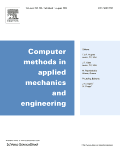
COMPUTER METHODS IN APPLIED MECHANICS AND ENGINEERING
Advancing the Frontiers of Computational Mechanics.COMPUTER METHODS IN APPLIED MECHANICS AND ENGINEERING, published by Elsevier Science SA, is a premier journal that has significantly contributed to the fields of computational mechanics, computer science applications, mechanical engineering, and the mechanics of materials since its inception in 1972. With an ISSN of 0045-7825 and an E-ISSN of 1879-2138, this journal is recognized for its rigorous peer-review process and is consistently ranked in the Q1 quartile across multiple categories, including Computational Mechanics and Mechanical Engineering. Its impressive Scopus rankings place it in the top tiers of its field, with a percentile ranking of 98th in Computational Mechanics. Researchers, professionals, and students will find the journal's comprehensive scope and high-quality articles invaluable for advancing their knowledge and practices at the intersection of engineering and computation. Although not an open-access journal, its impactful contributions to both theoretical and applied research make it an essential resource for anyone involved in these dynamic fields.
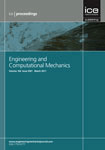
Proceedings of the Institution of Civil Engineers-Engineering and Computational Mechanics
Bridging Theory and Practice in Engineering ExcellenceProceedings of the Institution of Civil Engineers - Engineering and Computational Mechanics is a prestigious journal published by Emerald Group Publishing Ltd, dedicated to advancing the fields of civil and structural engineering, as well as mechanics of materials. With an ISSN of 1755-0777 and E-ISSN 1755-0785, this journal serves as a critical platform for disseminating innovative research and practical insights from 2009 through 2024. As part of its commitment to academic rigor, it is categorized in the Q4 quartile for both civil and structural engineering and mechanics of materials, reflecting a unique position in the scholarly community. The journal is essential for professionals, researchers, and students aiming to stay informed on current trends, methodologies, and applications in engineering and computational mechanics. By engaging with this publication, readers gain access to crucial findings that contribute to the advancement of infrastructure and materials science, vital for developing resilient and sustainable engineering solutions.

Izvestiya of Saratov University Mathematics Mechanics Informatics
Empowering Scholars with Cutting-edge Research InsightsIzvestiya of Saratov University Mathematics Mechanics Informatics is a prominent open access journal published by Saratov State University, focusing on the interdisciplinary fields of mathematics, mechanics, and computer science. Established as an accessible platform for researchers since 2007, this journal fosters the dissemination of innovative research and advancements in computational mechanics, general mathematics, and mechanical engineering among others. Although currently categorized within the Q4 quartile rankings in various domains, including Computational Mechanics and Mechanics of Materials, it serves as a crucial resource for professionals and scholars aiming to explore emerging trends and methodologies. Operating out of Saratov, Russian Federation, this journal not only contributes to local academic discourse but also holds international relevance, welcoming submissions that push the boundaries of traditional research. Researchers, professionals, and students alike are encouraged to engage with the wealth of knowledge presented within its pages, reinforcing the journal’s role as a vital component in the ongoing development of these scientific fields.

Numerical Mathematics-Theory Methods and Applications
Unveiling the Power of Numerical TechniquesNumerical Mathematics: Theory Methods and Applications, published by GLOBAL SCIENCE PRESS, stands as a pivotal journal in the fields of applied and computational mathematics, control and optimization, as well as modeling and simulation. With an ISSN of 1004-8979 and an E-ISSN of 2079-7338, this journal has been committed to disseminating high-quality research since its establishment in 2010, curating contributions that reflect the latest advancements in numerical methodologies and their diverse applications. As a Q2 journal in its category for 2023, it ranks favorably in the Scopus metrics, with notable positions in various mathematical disciplines. Although it does not currently provide open access, it remains an essential resource for researchers and professionals seeking to deepen their understanding of numerical methods and their applications. The journal’s esteemed reputation, coupled with its strategic focus on emerging trends in mathematics, makes it an invaluable platform for scholars who wish to contribute to and stay informed about cutting-edge developments in this dynamic field.
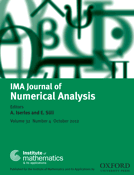
IMA JOURNAL OF NUMERICAL ANALYSIS
Connecting Researchers in the World of Numerical AnalysisIMA Journal of Numerical Analysis, published by Oxford University Press, stands as a premier platform for cutting-edge research in the field of numerical analysis, exemplifying the latest advancements and methodologies in applied, computational, and general mathematics. Since its inception in 1981, this esteemed journal has continually contributed to the academic community by publishing high-quality, peer-reviewed articles that foster innovation and collaboration among researchers. With an impressive Q1 ranking across multiple categories, including Applied Mathematics and Computational Mathematics, it plays a crucial role in disseminating knowledge, as indicated by its Scopus rankings which place it in the top 25% of journals within its field. Although the journal is not open access, it remains a vital resource for academics, professionals, and students eager to engage with the ongoing evolution of numerical methods. By serving as a conduit for novel ideas and rigorous research, the IMA Journal of Numerical Analysis ensures that its contributors and readers are at the forefront of this dynamic discipline.
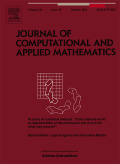
JOURNAL OF COMPUTATIONAL AND APPLIED MATHEMATICS
Bridging Theory and Application in MathematicsJOURNAL OF COMPUTATIONAL AND APPLIED MATHEMATICS, published by Elsevier, stands as a premier platform for researchers and practitioners in the fields of applied and computational mathematics. With an impressive convergence history from 1975 to 2025, this journal has established itself as a crucial reference point for innovative mathematical theories, methodologies, and applications. Holding a distinguished position in Scopus rankings—#85 out of 635 in Applied Mathematics and #36 out of 189 in Computational Mathematics—it operates in the highly competitive Q2 quartile for both disciplines as of 2023. Although currently not designated as an open-access journal, it remains widely respected for its rigorous peer-review process and high-quality research contributions. Researchers and professionals seeking to advance their work and engage with cutting-edge developments will find this journal an invaluable resource, fostering a deeper understanding and collaboration within the mathematical community.

COMPUTATIONAL MATHEMATICS AND MATHEMATICAL PHYSICS
Transforming Theoretical Concepts into Practical SolutionsCOMPUTATIONAL MATHEMATICS AND MATHEMATICAL PHYSICS is a prestigious journal published by PLEIADES PUBLISHING INC, dedicated to advancing the fields of computational mathematics and mathematical physics. With an ISSN of 0965-5425 and an E-ISSN of 1555-6662, the journal has established its importance within the academic community since its inception in 1985. It is classified in the third quartile (Q3) for computational mathematics in 2023, and while currently it does not offer open access options, it remains a valuable resource for researchers seeking to disseminate their findings and engage with cutting-edge developments in the field. The journal encompasses a broad spectrum of topics, including numerical analysis, applied mathematics, and the intersection of physics and computational techniques, highlighting its relevance in addressing complex problems in both theoretical and applied contexts. Scholars will find a platform that not only promotes rigorous research but also encourages collaboration and innovation within the scientific community.

JOURNAL OF ENGINEERING MATHEMATICS
Fostering interdisciplinary dialogue for a better tomorrow.Welcome to the JOURNAL OF ENGINEERING MATHEMATICS, a leading scholarly platform published by Springer that has contributed significantly to the fields of engineering and mathematics since its inception in 1967. With an esteemed Q2 ranking in Engineering and a Q3 ranking in Mathematics according to the latest categorization, this journal is recognized for its rigorous peer-reviewed content that showcases innovative research across various mathematical and engineering disciplines. Researchers and professionals alike will find valuable insights within its pages, as it covers theoretical developments and practical applications that are pivotal for advancing knowledge in these critical areas. The journal maintains a robust presence in the global academic landscape, evidenced by its positioning in the 74th percentile for General Mathematics and 52nd percentile for General Engineering in Scopus rankings. As we look forward toward our convergence years spanning from 1967 to 2024, the JOURNAL OF ENGINEERING MATHEMATICS continues to invite submissions that foster interdisciplinary dialogue and exploration, making it an essential resource for students, academics, and industry experts.

Computational Particle Mechanics
Advancing the Frontiers of Computational MechanicsComputational Particle Mechanics, published by SPRINGER INTERNATIONAL PUBLISHING AG, is a leading journal dedicated to advancing knowledge in the interdisciplinary fields of computational mechanics, civil engineering, and fluid dynamics. With an impressive impact factor reflecting its high-quality research publications, this journal maintains a strong presence in the academic community with a Q1 ranking in categories such as Civil and Structural Engineering, Computational Mechanics, and Numerical Analysis as per the latest 2023 evaluations. Researchers and professionals benefit from the journal's commitment to open-access options, promoting wider dissemination of groundbreaking studies. Operating under the Swiss publishing house since 2014, Computational Particle Mechanics aims to foster innovation through the exploration of particle-based methods and simulations, making significant contributions to methodologies within computational mathematics and modeling. As the journal continues to evolve until its converged years end in 2024, it stands as a vital resource for those looking to enhance their expertise in dynamic modeling and simulation techniques.

Advances in Applied Mathematics and Mechanics
Pioneering Research at the Intersection of Mathematics and MechanicsAdvances in Applied Mathematics and Mechanics is a premier academic journal published by GLOBAL SCIENCE PRESS that focuses on the latest research and innovative developments in the fields of applied mathematics and mechanical engineering. Since its inception in 2009, this journal has consistently contributed to the advancement of knowledge, garnering a respectable Q2 ranking in both Applied Mathematics and Mechanical Engineering categories, reflecting its significance in enhancing scientific discourse. With an impactful reach, as evidenced by its Scopus rankings, this journal hosts cutting-edge research, theoretical advancements, and practical applications that serve as invaluable resources for researchers, professionals, and students alike. While it operates under a subscription model, the accessibility of vital research findings is critical for driving innovation within these interrelated disciplines. The journal’s scope encompasses a broad range of topics, from computational methods to engineering applications, positioning it as a crucial platform for interdisciplinary collaboration and knowledge sharing in an ever-evolving academic landscape. For prospective authors and readers, Advances in Applied Mathematics and Mechanics stands as a key contributor to confidently navigating the nexus of applied mathematics and mechanics.